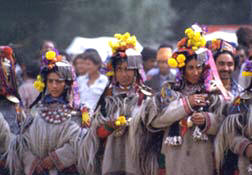Location: Near Hemis Gompa, Souteast Of Leh, Ladakh Region, J&K
Founded In: 1664 Significance: A Memorial To King Sengge Namgyal Clinging like a swallow's nest to the sides of a shay conical hill, the magnificent Gompa of Chemrey sees very few visitors because of its location - tucked up the side valley that runs from Karu, below  Hemis, to the Chang-la pass into Pangong. If one isn't having one's own vehicle, then be prepared to do some walking to get there. It takes around fifty minutes to follow the dirt track down to the river and up to the monastery after the Leh -Thak Thok bus drops one off beside the main road. Hemis, to the Chang-la pass into Pangong. If one isn't having one's own vehicle, then be prepared to do some walking to get there. It takes around fifty minutes to follow the dirt track down to the river and up to the monastery after the Leh -Thak Thok bus drops one off beside the main road.Founded in 1664 as a memorial to King Sengge Namgyal, the monastery is staffed by a dwindling community of around twenty Drugpa monks and their young novices. Its set of ancient Tibetan texts whose title pages are illuminated with opulent gold and silver calligraphy. Upstairs in the revamped Guru-La-Khang, reached via several flights of rickety wooden steps, sits a giant brass statue of Padmasambhava (founder of the Nyingmapa school), swatched in silk brocade and encrusted with semi precious stones. Its murals, painted in the early 1980s, are the work of an artist from Nimmu village. |
Vaishno Devi Tour Katra Town, lying in the foot of Trikuta Mountains, 48 kms. from Jammu, serves as the base camp for visiting the famous shrine of Shri Mata Vaishno Devi, which is approachable on foot along a 13 kms long well laid footpath. Every year, more than 4.5 million pilgrims pass through Katra on their way to the holy shrine. The cave shrine of Mata Vasihnodeviji or Trikuta Bhagwati (alt: 5,200 ft.) has been a beacon of faith and fulfilment to millions of devotees from all over the world. The pilgrimage to the Shrine holds great significance for the pilgrims. The Legend of Mata Vaishnodeviji. View of Vaishnodeviji from Bhavan Everyday of the year throngs of people surge up the steep pathways that cut across the Trikuta hillsides for mile after mile. This show of faith is finely interwoven with the cultural strands of the Indian subcontinent, and these pathways have been trod on for many centuries now. Popular belief holds that anybody who walks the Himala...
Comments
Post a Comment